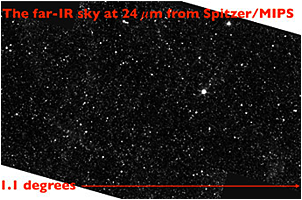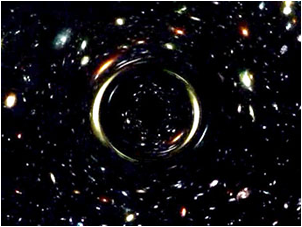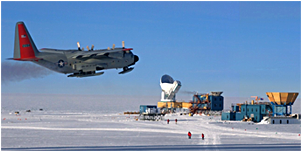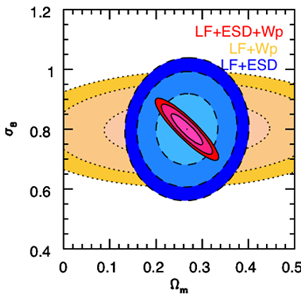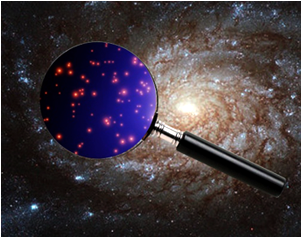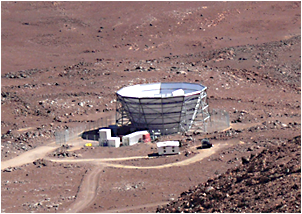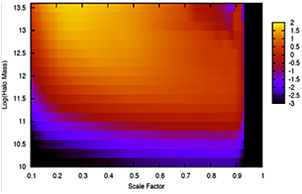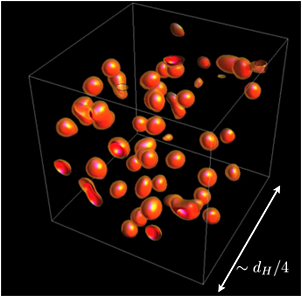 |
 |
 |
 |
 |
 |
 |
 |
 |
 |
 |
 |
|
Talks & Events
|
KICP Friday Noon Seminars: 2011 Observing the Evolution of the Universe through the CMB Encoded within the polarization and fine-scale temperature anisotropy of the cosmic microwave background (CMB) are potential answers to fundamental questions about the nature of dark energy, the energy scale of Inflation, the evolution of the first stars and galaxies, and their effect on the growth of cosmic structures. Only recently have detector and focal plane sensitivities improved to a level to make these measurements possible. This has been evidenced by recent measurements from the South Pole Telescope (SPT), which reported two notable firsts: 1) the first detection of secondary CMB anisotropy, and 2) the first galaxy cluster catalog selected by their spectral distortion of the CMB, also known as the Sunyaev-Zel'dovich (SZ) effect. I will review recent cosmological constraints from the SPT, preview future results from the SPT survey and its polarization sensitive camera, SPTpol, and finally discuss the experimental challenges and scientific goals for the next generation of CMB experiments. Probing the Early Universe with CMB Polarization Measurements from SPIDER and Planck The polarization of the cosmic microwave background (CMB) is a powerful tool for cosmology, encoding the history of the universe from inflation up to the era of structure formation. I will describe two experiments, SPIDER and Planck, that employ complementary strategies to measure CMB polarization with high precision over a wide range of angular scales. SPIDER is a balloon-borne multifrequency telescope with 0.5 degree resolution that is designed to map CMB polarization with high fidelity over ~10% of the sky. Planck is a satellite mission that has been operating since August 2009, and the High Frequency Instrument will yield four all-sky surveys at six frequency bands (100-857 GHz) with 4-10 arcminute resolution. SPIDER is optimized to constrain the amplitude of inflationary gravitational waves by searching for a B-mode polarization signature in a multipole range where the signal is expected to peak. Planck, in contrast, will effectively target the largest angular scales, which are sensitive to reionization history, and will produce cosmic variance limited measurements of E-mode polarization up to ell~1000. Together, the combination of SPIDER and Planck will produce a rich data set that will provide numerous insights into the history of the universe. Experimental Gravity with LIGO The direct detection of gravitational waves (GWs) offers a revolutionary new probe of the most energetic processes in the universe and a precision test of general relativity. The 4 km long LIGO interferometers have demonstrated the sub-attometer displacement sensitivity (< 10^{-18} m/ Hz^{1/2}) and continuous operation (> 75\% duty factor) needed to detect GWs out to the Virgo cluster, but none have yet been seen. Starting in 2008, we began construction of a 2nd generation of interferometers, Advanced LIGO, to increase the detector sensitivity and bandwidth by more than an order of magnitude. In this talk I will review the next five years of physics challenges and experiments involved in building and commissioning Advanced LIGO. We will discuss our plans to commission active seismic isolation systems with picometer displacement noise, low-loss passive isolation systems with mechanical quality factors >10^7, and Michelson interferometers with 750 kW of stored power. Together, these systems form a detector capable of detecting the 2x10^{-20} m GW signal from two black holes coalescing 6 billion light years away. We expect Advanced LIGO to detect the most powerful sources -- the merger of two compact objects such as neutron stars and black holes -- with rates from a few to many per year. The GW waveform, together with electromagnetic observations, will allow tests of the physics of black holes and general relativity. As the Advanced LIGO program continues, we will continue to improve the interferometer sensitivity using advanced integrated photonics, novel materials, and advanced quantum measurement techniques. I will conclude with a brief discussion of the Fermilab Holometer, an experiment that uses technology from LIGO to search for hypothetical two dimensional fluctuations in space-time coordinates known as holographic noise. The Fermilab Holometer uses two independent, 40 m long Michelson interferometers to measure correlated fluctuations in the positions of their beam splitters. The experiment is designed to have 5-sigma sensitivity to the Planck scale with a 30 minute integration time and could have results in late 2011. Cosmology with Type II Supernovae CANCELLED Strong Lensing in Clusters of Galaxies: Using Nature's Largest Telescopes New Constraints on the Highest-Energy Cosmic-Ray Electrons and Positrons The measured spectrum of cosmic-ray electrons/positrons can provide insight into the rich history of high-energy astrophysical processes near Earth. However, until quite recently, knowledge of this quantity could be called, at best, uncertain. Fortunately, needed clarity has been brought in the range of energies from ~10 GeV up to a few TeV by Fermi, PAMELA, and HESS, though for higher energies no measurements yet exist. I will address how we can extend our knowledge of the cosmic-ray electron population beyond the current high-energy frontier in order to improve our understanding of high-energy sources throughout the Galaxy. Multi-Messenger Approach for Revealing Extragalactic High-Energy The origin of high-energy cosmic rays, especially ultra-high-energy cosmic rays (UHECRs), has been one of the biggest mysteries in physics and astronomy. The multi-messenger approach, using neutrinos and gamma rays as well as cosmic rays, is necessary in order to reveal the sources. Recently a Gton neutrino detector, IceCube, has been completed, and several Cherenkov gamma-ray telescopes as well as the gamma-ray satellite Fermi are now operating, so that the era of the multi-messenger observations is coming. The importance the multi-messenger approach is even greater if cosmic rays are transiently produced by bursts or flares and/or they are heavy nuclei rather protons, since cosmic rays experience long time delays and/or large deflections due to the cosmic magnetic fields. In this talk, we discuss characteristic signals from extragalactic astrophysical sources, which could be crucial for identifying the accelerators of UHECRs. Understanding the Global Course of Galaxy Evolution at z < 1 Evolution in the global galaxy population over the past 7 Gyr has been dominated by two principal trends: a dramatic decline in the average level of star-formation activity combined with a substantial growth in the stellar mass density within the red galaxy population. While both of these evolutionary trends are well measured at z < 1, the physical mechanisms responsible remain somewhat poorly understood. Using data from the DEEP2 Galaxy Redshift Survey in concert with complementary observations spanning UV to radio wavelengths, I will present recent results that directly constrain the physical processes driving the global transformation in galaxy properties at z < 1. In particular, I will discuss ongoing work to probe the cold gas component of star-forming galaxies at high redshift, which is providing direct constraints on the fuel supply for star formation when the Universe was less than half its current age. Finally, I will conclude by outlining the limitations of the current data sets and how they might be overcome with future ground- and space-based facilities. Galaxy Clusters and Weak Lensing - a view from the Western Suburbs I will present results involving galaxy clusters and weak lensing using three different optical imaging surveys: the Deep Lens Survey, the Sloan Digital Sky Survey, and the SDSS Coadd. I will also present an update of this topic in the forthcoming Dark Energy Survey. QUBIC: The QU Bolometric Interferometer for Cosmology One of the major challenges of modern cosmology is the detection of B-mode polarization anisotropies in the Cosmic Microwave Background. These originate from tensor fluctuations of the metric produced during the inflationary phase. Their detection would therefore constitute a major step towards understanding the primordial Universe. The expected level of these anisotropies is however so small that it requires a new generation of instruments with high sensitivity and extremely good control of systematic effects. We propose the QUBIC instrument based on the novel concept of bolometric interferometry, bringing together the sensitivity advantages of bolometric detectors with the systematics effects advantages of interferometry. The instrument will directly observe the sky through an array of entry horns whose signals will be combined together using an optical combiner. The whole set-up is located inside a cryostat. Polarization modulation will be achieved using a rotating half-wave plate and the images of the interference fringes will be formed on two focal planes (separated by a polarizing grid) tiled with bolometers. We show that QUBIC can be considered as a synthetic imager, exactly similar to a usual imager but with a synthesized beam formed by the array of entry horns. Scanning the sky provides an additional modulation of the signal and improve the sky coverage shape. The usual techniques of map-making and power spectrum estimation can then be applied. We show that the sensitivity of such an instrument is comparable with that of an imager with the same number of horns. We anticipate a low level of beam-related systematics thanks to the fact that the synthesized beam is determined by the location of the primary horns. Other systematics should be under good control thanks to an autocalibration technique, specific to our concept, that will permit the accurate determination of most of the instrumental parameters that would otherwise lead to systematics. Propagation of Galactic Cosmic Rays: The Measurement of the Boron-to-Carbon Ratio of TRACER The big question in cosmic-ray physics is still open: What are the cosmic-ray sources and their properties? In order to be able to investigate the sources, the propagation of cosmic rays through the Galaxy must be understood, since it modifies the source spectra until they can be observed at the Earth. In a simple propagation model a cosmic-ray particle may reach the Earth, may escape the Galaxy, or may spallate into a lighter, secondary nucleus. The faster the escape from the Galaxy takes place, the fewer secondary nuclei are produced. Therefore, information on the propagation of Galactic cosmic rays can be inferred from the abundance ratio of secondary to primary cosmic-ray elements, like the boron-to-carbon ratio. Measuring this ratio poses formidable experimental challenges as the observations have to be conducted above the atmosphere and large exposure is needed to reach high energies. The TRACER detector was designed to achieve this measurement. It is currently the largest balloon-borne detector and capable of detecting cosmic rays well into the TeV/amu energy region with single element resolution. Here we present the results of the last long-duration balloon flight of TRACER, including a new measurement of the boron-to-carbon ratio up to 2 TeV/amu. We also present implications of this measurement for cosmic-ray propagation and, subsequently, their sources. Elements of MHz Radio Emission and Radio Detection of the Electric Field Emitted by the Extensive Air Showers The properties of ultra-high energy cosmic rays have to be inferred from the extensive air shower (EAS) of secondary particles that they produce in the atmosphere. Our current EAS detection technique involves two components. The first employs instruments deployed in a large surface array that sample the particle density as the EAS arrives. Then, the second uses telescopes to collect the fluorescence light emitted from atmospheric nitrogen excited by charged particles of the EAS. An alternative detection approach could be the radio detection of the electric field emitted by the charged particles of the EAS. I will present some basics of radio emission in the MHz range and show that the predicted signal is representative of the longitudinal profile of the EAS allowing the identification of the incoming cosmic ray. Then, we will discuss the experimental aspect of this domain with the presentation of the CODALEMA experiment installed at the Nancay Observatory in France. Finally, the last results from the radio detection experiments located at the site of the Pierre Auger Observatory will be presented. Primordial Non-Gaussianity in Large-scale Structure Primordial non-Gaussianity is among the most promising of few observational tests of physics at the inflationary epoch. At present non-Gaussianity is best constrained by the cosmic microwave background, but in the near term large-scale structure data may be competitive so long as the effects of primordial non-Gaussianity can be modeled through the non-linear process of structure formation. I will discuss recent work modeling effects of a few types of primordial non-Gaussianity on the large-scale halo clustering and the halo mass function. More specifically, I will compare analytic and N-body results for two variants of the curvaton model of inflation: (i) a "tau_NL" scenario in which the curvaton and inflaton contribute equally to the primordial curvature perturbation and (ii) a "g_NL" model where cancellations vanish the usual quadratic f_NL term in the potential, but give rise to a large cubic term. Recoiling Black Holes in Merging Galaxies Ample evidence suggests that the growth of SMBHs and their host galaxies is closely linked. However, in the event of a merger, gravitational-wave (GW) recoil may displace a SMBH from its galactic center, or eject it entirely. To explore the consequences of this phenomenon, we use hydrodynamic simulations of gaseous galaxy mergers that include GW recoil kicks to the merged BHs. We have conducted a large parameter study with a range of recoil velocities and galaxy merger models, enabling us to identify systematic trends in the behavior of recoiling BHs. Specifically, I will describe our results concerning (i) the dynamics of recoiling BHs in gaseous merger remnants, (ii) their observable signatures, including kinematically- and spatially-offset AGN, and (iii) their effects on the co-evolution of BHs and galaxies, including scatter in the BH-bulge relations and extended starburst phases in the merger remnant. Cosmological Constraints from a Clustering & Lensing CANCELLED I present a new method to use a combination of galaxy-galaxy lensing and galaxy clustering to constrain cosmological parameters. This method uses the halo model plus a description of halo occupation statistics to describe the galaxy-dark matter connection, and is complementary to and competative with other techniques to contrain cosmological parameters, such as SNIa, BAO, cluster abundances and cosmic shear. After describing the method, I will show constraints on various cosmological parameters, discuss implications, and some future applications. The recent observation of the ultra-high energy universe with the IceCube neutrino telescope IceCube is a cubic kilometer scale, deep-ice neutrino detector which had been under construction at the South Pole since January 2005 and the construction was completed in December 2010. IceCube's high energy neutrino search includes the TeV energy region, where atmospheric neutrinos are dominant, and the EeV regime, where ultra-high energy cosmic-ray emissions play leading roles in the flow of astrophysical energies. The 2008-2009 science run with the partially (~50 %) constructed detector has surveyed neutrino emissions with the world's best sensitivity from TeV energies to far beyond. This talk will report the most recent results of observations of the neutrino universe from 1016eV to 1020eV by IceCube. The results constrain the ultra-high energy cosmic-ray radiations at cosmological distances and will be discussed in context of the Fermi-LAT diffuse gamma-ray measurement in the GeV region. What to do with 400,000 Astronomers Citizen science - the involvement of volunteers in the analysis of scientific data - has the potential to make a huge impact in this era of widespread broadband and enormous data sets. In this talk, Galaxy Zoo principal investigator Chris Lintott, will tell the story of and review the results from one of the largest distributed projects, which recruited hundreds of thousands of volunteers to provide hundreds of millions of classifications of galaxies drawn from the Sloan Digital Sky Survey and from Hubble Space Telescope surveys. Drawing on education research and game design, the talk will also cover the evolution of the project from Galaxy Zoo to the Zooniverse, a collection of projects which has volunteers hunting for planets, scouring the lunar surface and even examining ancient papyri. Modified Gravity makes Galaxies Brighter Attempts to modify gravity to achieve late time cosmic acceleration usually run into already stringent solar system constraints on general relativity (GR). Recently, it is realized that one can evade these constraints via "screening" -- one construct theories where the effective gravity is dependent on ambient gravitational potential, hence since the solar system is embedded in a deep potential well of the Milky Way and local Group, GR is restored. Meanwhile at cosmological scales, gravity can be modified to resemble dark energy. Such theories include the venerable f(R) gravity theory, and the more recent trendy models such as the Chameleon and the Symmetron. I will show that modified gravity will change the stellar structure equations dramatically in dwarf galaxies not associated with clusters. Stars in these galaxies are generically hotter and more luminous, and live much shorter lives as a result. Not only are the galaxies then brighter, they are also bluer -- allowing us to put new bounds modified gravity by an order of magnitude or more. Infrared-luminous galaxies: their evolution, clustering, and fates Infrared-luminous galaxies are powered by star formation or active galactic nuclei, but emit much of their light as radiation reprocessed by dust into the far infrared. The most massive starbursts in both the local and high redshift universe manifest themselves as ultraluminous infrared galaxies. This class of galaxies was discovered by IRAS and studied extensively with Spitzer. However, it remains controversial what IR-luminous galaxies at z=1 are, and what they will evolve into. Are IR-luminous galaxies at high redshift mostly galaxy mergers, as they are at low redshift? Are ultraluminous IR galaxies strongly clustered, and can we infer whether they must evolve into cluster galaxies today? I will discuss these questions using data from Spitzer/MIPS, HST, and the DEEP2 redshift survey. I will also show near-infrared slitless spectroscopy from the new WFC3 instrument on Hubble, and its application as a probe of star-forming galaxies at high redshifts. Near-IR slitless spectroscopy from space is a technique planned for the WFIRST satellite and prefigures the science it can yield for studying galaxy evolution. Using weak lensing to probe the link between galaxies and dark matter I will present a new theoretical framework that combines measurements of galaxy-galaxy lensing, galaxy clustering, and the galaxy stellar mass function in a self-consistent manner. While considerable effort has been invested in exploring each of these dark matter probes individually, attempts to combine them are still in their infancy despite the potential of such combinations to elucidate the galaxy-dark matter connection, to constrain cosmological parameters, and to test the nature of gravity. I will then present an application of this model to the COSMOS data and will show how the stellar-to-halo mass relation evolves from z=1 to z=0. Finally, I will discuss the potential of future weak large surveys for galaxy-galaxy lensing measurements and I will show some early work from a new 170 deg2 weak lensing survey ("CS82") we have recently completed in the Stripe82 equatorial region. The Search for CMB B-Mode Polarization Precise CMB temperature and polarization measurements strongly support the theory of inflation, a period of exponential super-luminal expansion in the instant following the big bang. However the physical basis of inflation remains elusive, arising at energy scales beyond the reach of terrestrial particle accelerators. Inflation also generates a background of gravitational waves that imprint a distinct 'B-mode' polarization pattern on the CMB, with an amplitude that depends on inflationary physics. An active competition between a dozen current experiments is well underway to detect or constrain inflationary polarization. We describe a CMB polarization program at the South Pole, progressing from BICEP, with the current best upper limits on inflationary polarization, to the Keck Polarimeter Array, partially deployed in the field, to POLAR, now in development with a large and sensitive bolometric focal plane array. POLAR is also designed to map the yet-undetected polarization signal from gravitational lensing of the background CMB by intervening matter, a new cosmological tool for probing the formation of large-scale structure. Advances in superconducting bolometer arrays with planar antennas are propelling this rapid improvement in capability. We describe recent results, efforts to control systematic errors, and new innovations. This program ultimately has the capability to search to an amplitude of r ~ 0.01, below which it becomes necessary to remove Galactic and CMB lensing polarization foregrounds. These developments inform the scientific and technical case for the Inflation Probe, a future space-borne CMB successor to the ESA Planck satellite. Constraining Asymmetric Dark Matter Asymmetric dark matter takes the coincidence between the baryon and dark matter densities as the basic principle around which to build models. In this talk, I will provide an overview of the asymmetric models currently on the market. I will then discuss experimental constraints which apply to broad classes of these models, and their implications for a successful asymmetric scenario. Cosmological Constraints from a Combined Analysis of Clustering and Galaxy-Galaxy Lensing in the SDSS In recent years much progress has been made in constraining halo occupation statistics, the statistical description of how galaxies of different properties are distributed over dark matter halos of different mass. This progress is due to (i) a dramatic increase in data in the form of galaxy redshift surveys, and (ii) the development of the Halo Model, which allows for an analytical description of the non-linear dark matter mass distribution in terms of its halo building blocks. After an introduction to the Halo Model, I present the Conditional Luminosity Function, which is a statistical tool to describe the galaxy-dark matter connection, and show how it can be constrained using either galaxy clustering or galaxy-galaxy lensing. Next, I show that a combination of these two data sets allows one to put tight constraints on cosmological parameters, in a manner that is both complementary to and comparative with other probes, such as Baryon Acoustic Oscillations, Cosmic Shear and SuperNovae Ia. Finally I give some brief examples of how halo occupation statistics can be used to further our understanding of galaxy formation and evolution. Dark matter microhalos: messengers from the early universe The abundance of dark matter microhalos depends on the primordial power spectrum and the thermal history of the Universe. First, I will show how an effectively matter-dominated era between the end of inflation and the onset of radiation domination leaves an imprint on the small-scale matter power spectrum. This imprint depends on the origin of dark matter and can trigger the formation of numerous dark matter microhalos during the cosmic dark ages. Second, I will describe how large primordial perturbations on small scales can similarly lead to early-forming microhalos. These microhalos may be detected through their astrometric microlensing signatures, and I will show how a high-precision astrometry survey like Gaia can be used to probe the primordial power spectrum on very small scales. A new view of the CMB from the ATACAMA cosmology telescope Over the coming decade, tiny fluctuations in temperature and polarization of the Cosmic Microwave Background (CMB) will be mapped with unprecedented resolution. The Planck Surveyor, the Atacama Cosmology Telescope (ACT), and the South Pole Telescope (SPT) are already making great advances. In a few years, high resolution polarization experiments, such as PolarBear, ACTPol, and SPTPol will be in full swing. While these new arc-minute resolution observations will continue to help constrain the physics of the early universe and possible deviations from the Standard Model, they will also be unique in a new way - they will allow us to measure the gravitational lensing of the CMB. This lensing is the deflection of CMB photons by intervening large scale structure. CMB lensing will probe the growth of structure over cosmic time, helping constrain the total mass of neutrinos and the behavior of dark energy. In the first part of the talk, I will review the recent progress made with ACT. In the second part, I will discuss the scientific potential of the CMB lensing signal, its first detection, a new way to constrain dark energy, and its prospects for cross-correlation with other datasets. Finally, I will discuss the upcoming polarized counterpart of ACT --- the ACTPol project, which will have greater sensitivity than ACT, and will be a premier CMB lensing experiment. I will describe our plans to extract different flavors of science from the ACTPol data, including the cross-correlations with optical lensing and galaxy surveys, such as SDSS, BOSS, DES and LSST. Constraining the Complete Star Formation History of Observable Galaxies from z=0 to z=8 We present a comprehensive approach for deriving the star formation history of the universe self-consistently with a wide array of observations (stellar mass functions, stellar mass clustering, specific star formation rates, and the cosmic star formation rate) and with merger rates from N-body simulations in the context of LCDM cosmology. Our approach explores a wide parameter space of systematic uncertainties, allowing a broader range of possible star formation scenarios at high redshifts; these uncertainties include aspects (e.g., a steeper faint-end slope for the stellar mass function) which help resolve tensions between the cosmic star formation rate and stellar mass functions for LBGs at z>1. We present derived constraints on the star formation rates and histories for galaxies as a function of stellar and halo mass from z=0 to z=8. We show that constraints from observations favor a clear change in the star formation rates of massive galaxies around z=2, consistent with a transition from cold-mode to hot-mode accretion at that redshift and very old stellar populations at the present day. We find, on the other hand, that low-mass galaxies do not have a similar break and that many have star formation histories which have been increasing ever since the galaxies first formed. We also discuss the largest uncertainties on current constraints and the direction that future surveys should take to best increase our understanding. In summary, we provide for the first time a complete, consistent picture of the evolutionary path of galaxies over 96% of the history of the universe, with profound implications for galaxy simulations, semi-analytic models, and our understanding of star formation in the cosmos. NuSTAR: Unveiling the Hard X-ray Universe The Nuclear Spectroscopic Telescope Array (NuSTAR) mission will carry the first focussing Hard X-ray (6-80 keV) telescope into orbit in Feb 2012. Using grazing incidence optics and pixelated CdZnTe detectors, it will offer two orders of magnitude increase in sensitivity and an order of magnitude improvement in angular resolution over any previous instrument working in this energy range. The two-year primary science mission focuses on four key programs: studying the cosmic evolution of black holes, understanding the populations of compact objects and the nature of the central black hole in the Milky Way, constraining the explosion dynamics and nucleosynthesis in supernovae, and probing the nature of particle acceleration in active galactic nuclei. A number of additional observations will be included in the primary mission, and a guest observer program will be proposed for an extended mission to expand the range of scientific targets. I will talk about the instrument capabilities of NuSTAR and discuss the science programs. Gravity Waves from Cosmological Phase Transitions Cosmological phase transitions occurred. I will talk about recent advances in modeling possible phase transitions when these transitions are mediated by scalar fields. I will discuss first- and second-order transitions, at various scales, and show how we can compute the background of stochastic gravitational waves produced during (and after) these transitions. WFIRST and Euclid The past decade has seen tremendous progress in astronomy that has brought us to the brink of being able to answer two very fundamental questions: What is the Universe made of? Are we alone? The first question can only be answered by trying to understand the mysterious 'dark energy' causing the accelerated expansion of the Universe. This dark energy, the dominant constituent of the Universe, has a number of possible theoretical explanations, ranging from a cosmological constant, to possible modifications to Einstein's General Theory of Relativity. The second question is motivated by the increasing frequency of detections of exoplanets and can be explored by seeking out the frequency of Earth-like planets in the habitable zone of stars similar to the sun. Both of these science goals can be best explored with a space-based wide-field telescope capable of imaging and spectroscopy. Such a platform, operating in optical to near infrared wavelengths would also make great strides in a myriad of ancillary astrophysical areas, including the evolution of galaxies and structures over two thirds of the age of the Universe. The European Space Agency is in the final stages of examining the Euclid mission, which is optimized to study dark matter and dark energy. NASA has begun planning for the Wide Field Infrared Survey Telescope designed to explore dark energy and perform an exoplanet survey. I'll discuss the scientific motivations of both missions and give an overview of the hardware, observing strategy and status of each mission. Lumps and bumps in the early (and late) universe In this talk I will address the following two (related) questions (1) What does the universe could look like at the end of inflation in the early universe ? (2) What if dark energy undergoes a phase transition in the late universe (similar to the one undergone by the inflaton at the end of inflation)? Both involve understanding some novel nonlinear scalar field dynamics which could also have implications for axionic dark matter. (1) How did inflation end? I will discuss the different scenarios of of the end of inflation, concentrating on a particular (new) scenario: the fragmentation of the inflaton into localized, long-lived excitations of the inflaton field (oscillons), which can end up dominating the energy density of the universe. I will provide conditions for the existence, stability, emergence and domination of oscillons after inflation as well as their theoretical and possible observational consequences. (2) In the second half, I will discuss the observational consequences of the quintessence field rolling to and oscillating near a minimum in its potential, "if" it happens close to the present epoch. The oscillations can lead to a rapid growth of the field fluctuations and the gravitational potential (times scales<< H^(-1)) on subhorizon scales. The gravitational potential power spectrum changes in a scale-dependent manner, however, the dark matter/galaxy power spectrum and the expansion history need not be significantly affected. Such a transition in the quintessence field can be constrained best by Integrated Sachs-Wolfe (ISW) and lensing. Two quoted "signatures" of modified gravity are a scale-dependent growth of the gravitational potential and a difference between the matter power spectrum inferred from measurements of lensing and galaxy clustering. Here, both effects are achieved by a minimally coupled scalar field in general relativity with a canonical kinetic term. |

